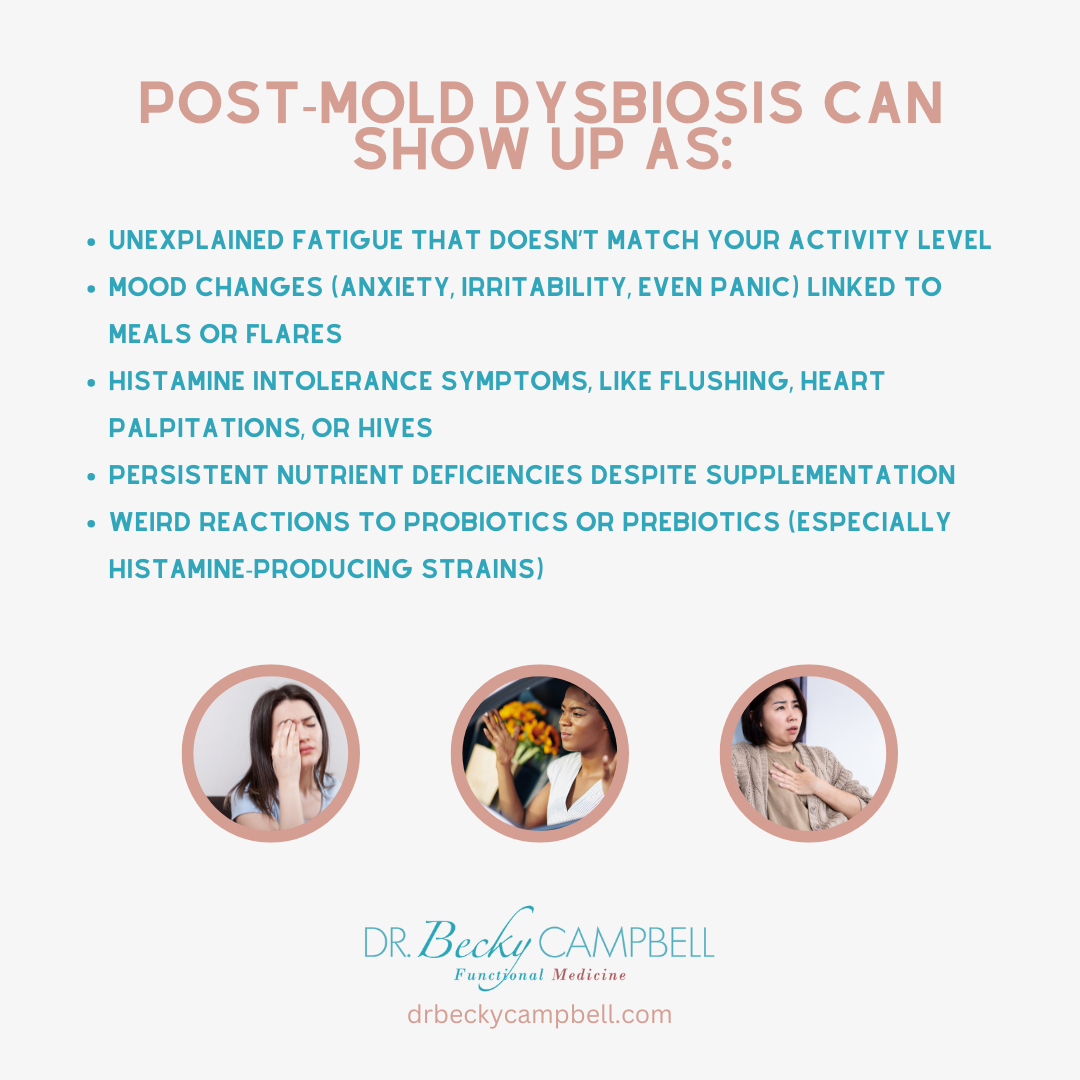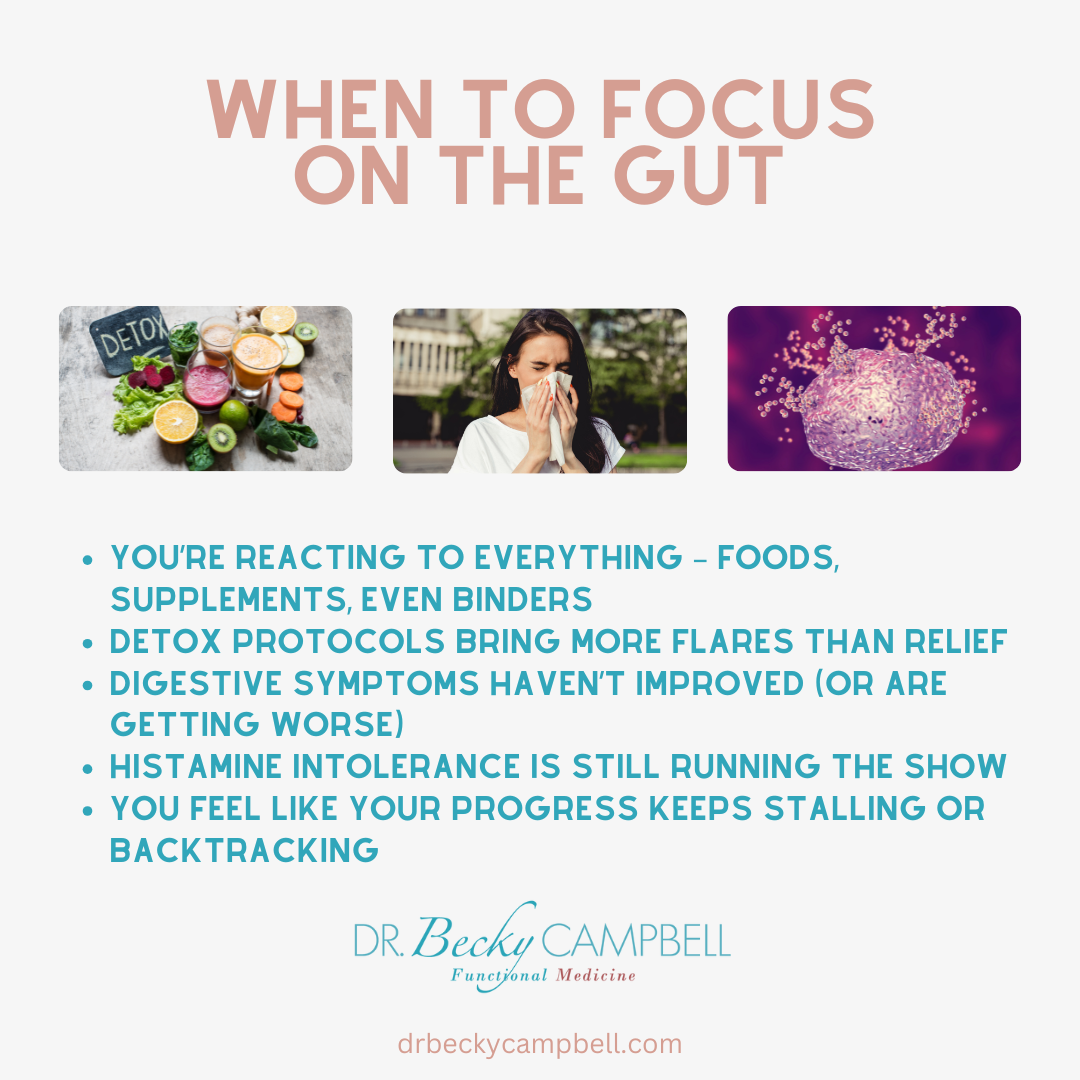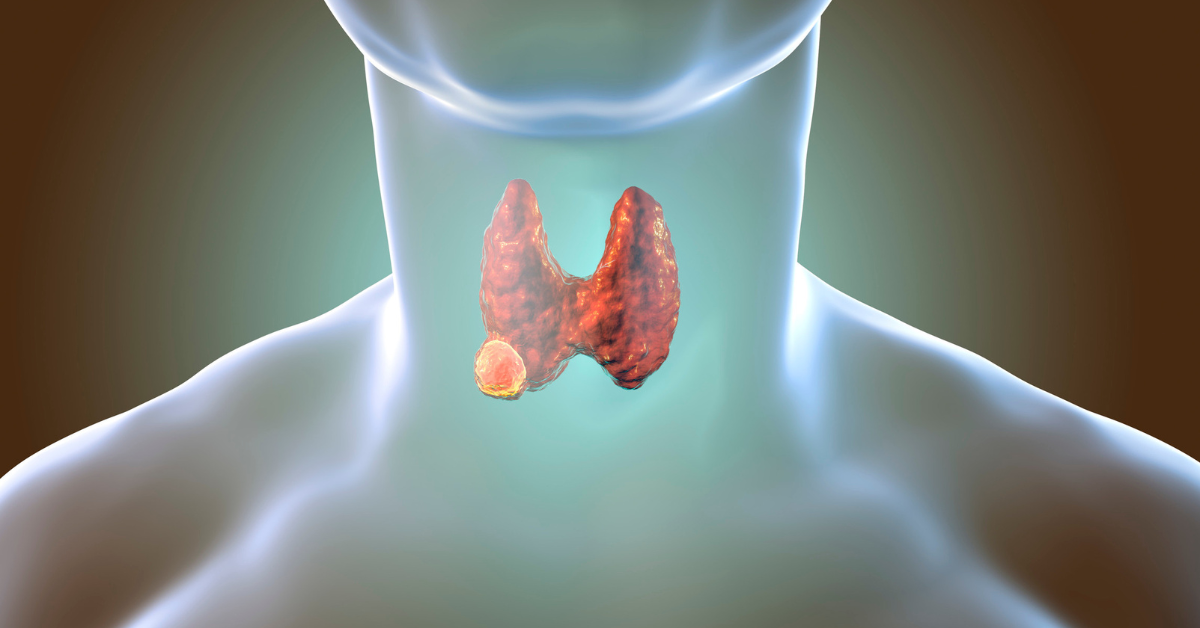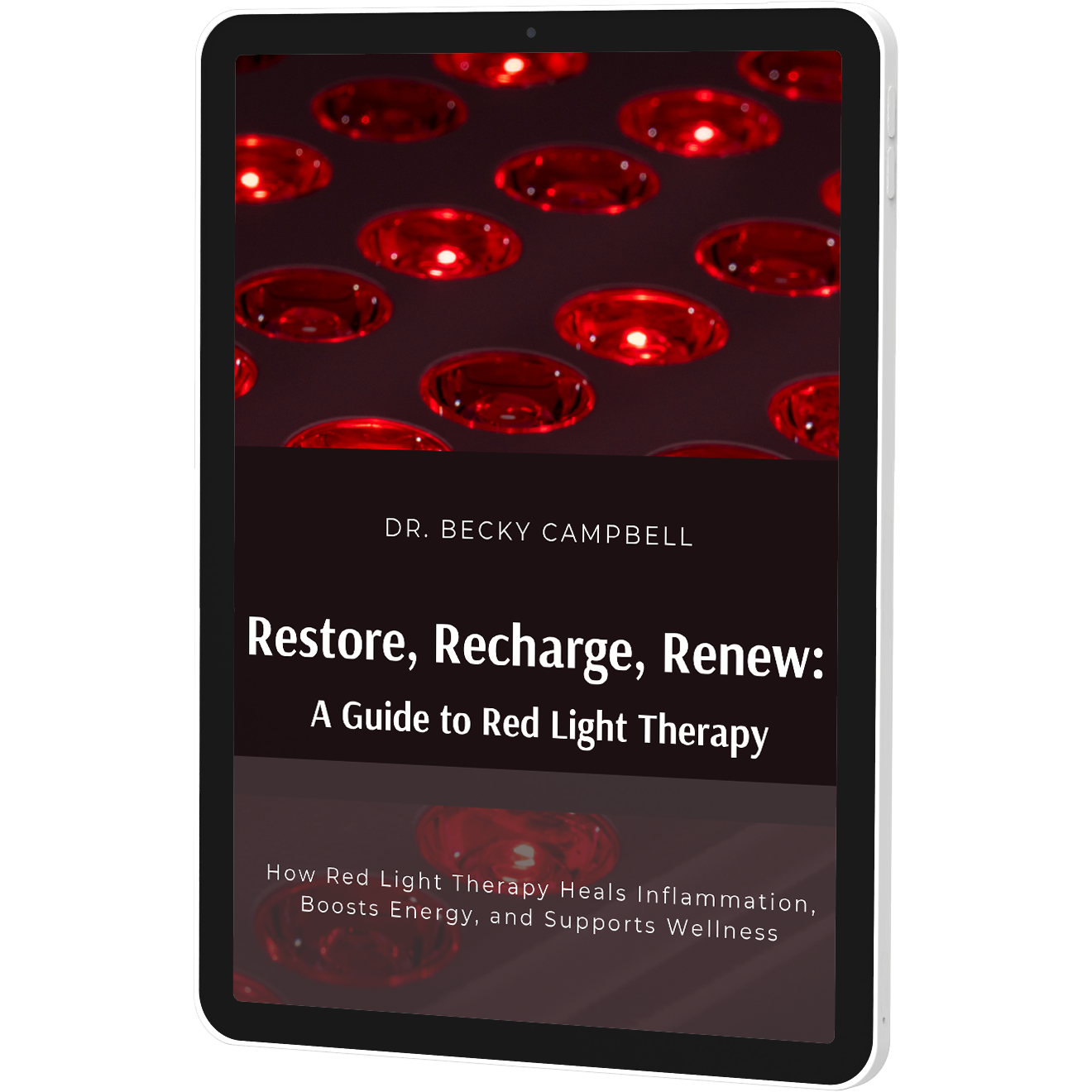The science behind mold-induced dysbiosis and why it keeps driving inflammation, leaky gut, and immune dysregulation long after exposure.
You did the hard part. You got out of the moldy home, office, or school. Now, you started working on detox. Maybe you’ve even changed your diet, added in binders, and started a protocol.
And yet…the symptoms are still there.
This is one of the most frustrating and confusing parts of mold illness recovery. You remove the exposure, but your body doesn’t bounce back the way you expected.
You’re still reacting. You still feel inflamed.
While mold exposure is known for its impact on inflammation, immune function, and detox pathways, there’s another piece that often gets overlooked: the gut microbiome.
Mold and the mycotoxins that come with it can disrupt the balance of microbes in your gut in ways that don’t just resolve with time. This microbial imbalance, or dysbiosis, can keep driving inflammation, contribute to leaky gut, and make it harder for your body to move forward.
So, let’s look at what happens to the gut after mold exposure, how to recognize the signs of mold-related dysbiosis, and what you can do to support your microbiome without overwhelming your system.
Because when the gut is supported, everything else starts to shift.
How Mold Disrupts the Gut Microbiome
The gut often gets left out of the mold conversation, but it’s one of the most deeply affected systems. Even if you never ate anything moldy, your microbiome felt the hit.
That’s because mold exposure doesn’t just stay in your sinuses or lungs. Mycotoxins move through your system, triggering inflammation and stress that ripple through the entire body, including the gut.
One of the first things to go? Microbial diversity.
You lose key players like Akkermansia, Bifido, and Lacto strains, and in their place, less helpful – and sometimes even inflammatory – microbes take over. (1, 2)
This shift doesn’t just mess with digestion. It also changes how your immune system behaves.
The gut and immune system are in constant conversation, and when mold disrupts that crosstalk, it can push your immune response into overdrive.
Hello, food sensitivities, chronic inflammation. Hello, vicious cycle.
And when the gut lining itself gets damaged (thanks, mycotoxins), you’re looking at leaky gut layered on top of it all.
So no, your gut hasn’t “just not caught up yet.” It’s been hit hard. And it needs attention.
Signs of Mold-Related Dysbiosis
If your gut hasn’t felt “normal” since your mold exposure, it’s not a coincidence. Dysbiosis after mold is incredibly common, and it rarely looks the same for everyone.
For some, it’s the sudden onset of food sensitivities. Foods you used to tolerate just fine – eggs, avocado, sauerkraut – now leave you feeling bloated, brain-fogged, or flaring.
For others, it’s the stubborn constipation, loose stools, or that feeling like food just sits there after you eat.
But the signs go beyond digestion.
Post-mold dysbiosis can show up as:
- Unexplained fatigue that doesn’t match your activity level
- Mood changes (anxiety, irritability, even panic) linked to meals or flares
- Histamine intolerance symptoms, like flushing, heart palpitations, or hives
- Persistent nutrient deficiencies despite supplementation
- Weird reactions to probiotics or prebiotics (especially histamine-producing strains)
If you’ve done stool testing, you might see low diversity, low levels of beneficial species, an overgrowth of gram-negative bacteria, or high markers of inflammation like calprotectin or secretory IgA.
This isn’t just about an “off” gut. Mold throws the whole system into imbalance, and your microbiome ends up on the front lines.
When you know what to look for, the gut starts making a lot more sense.
Why Gut Issues Stall Recovery
By now, it’s clear that mold doesn’t just disrupt the gut; it also rewires how your entire system responds to food, supplements, and stress. But here’s where things get tricky: even after you’re out of the moldy environment, your gut might still be stuck in survival mode.
And that can quietly sabotage your recovery.
A damaged gut lining and microbial imbalance don’t just affect digestion. They change how your body handles everything – from toxins to treatments.
When the gut is inflamed or leaky, it often leads to reabsorption of mycotoxins through the enterohepatic circulation. (3) In other words, your liver dumps toxins into the gut, and instead of getting rid of them, your body takes them right back in.
That alone can keep symptoms smoldering.
At the same time, dysbiosis makes the gut hypersensitive. You might find yourself reacting to binders, antimicrobials, probiotics, and even gentle foods. Not because those tools are bad, but because your gut isn’t ready.
The more inflamed it is, the less tolerance it has for change.
This also means your immune system stays on high alert. That’s a huge reason why histamine issues persist and why minor exposures or stressors can trigger major flares.
So if you’ve plateaued or felt worse during a detox, it might not mean you’re doing too much. It could mean you skipped a step.
Until your gut can regulate, absorb, and let go again, the rest of your recovery has a much harder time working.
How to Support the Gut After Mold
If you’ve felt like nothing’s working or like every step forward comes with a crash, it might be time to shift the goal. Instead of “fighting” mold or fixing the gut all at once, the real magic often happens when you slow down and work with your body’s pace, not against it.
The gut has its own timeline. And after mold, that timeline may need more space, more gentleness, and a lot more trust.
Here’s where to start:
Rebuild microbial diversity, slowly. Start with gentle, supportive herbs like ginger, chamomile, and fennel, which can encourage microbial balance and soothe the gut without adding stress. If tolerated, low-fermentable, whole-food fiber sources like zucchini, carrots, or lightly cooked greens can also help support diversity without overwhelming a sensitive system.
Choose probiotics wisely. Broad-spectrum, high-dose probiotics can backfire when the gut is inflamed or histamine-prone. Instead, start with low-histamine strains, such as Lactobacillus rhamnosus GG, Bifidobacterium infantis, or Bacillus coagulans, and listen closely to how your body responds.
Soothe the gut lining. Nutrients like L-glutamine, zinc carnosine, deglycyrrhizinated licorice (DGL), and marshmallow root can help calm inflammation and support tissue repair.
Use binders that don’t overwhelm. Instead of diving into aggressive detox, try gentle binders like chlorella, bentonite clay, or modified citrus pectin. Even here, less is often more.
What to skip?
Aggressive gut-clearing protocols or antimicrobials that don’t account for your current resilience. If the gut isn’t ready, those “kill” strategies can cause more harm than good.
Stool testing, like the GI-MAP or other tools we use in our virtual practice, can offer a clearer picture of what’s really going on. It can reveal low diversity, inflammatory markers, or imbalances in key species. This type of data helps personalize your plan and move forward with greater clarity, rather than relying on trial and error.
Recovery isn’t a race. It’s a conversation. And your gut is always trying to tell you what it needs next.
When to Focus on the Gut
You’ve seen how mold can disrupt the microbiome, inflame the gut lining, and throw the whole system off balance. But it’s not always obvious when the gut needs to take center stage in your recovery.
If you’re still feeling stuck, even after leaving mold behind and starting treatment, this is your reminder to zoom out and ask:
Is my gut ready for the work I’m asking it to do?
Here are a few signs it might be time to shift your focus:
- You’re reacting to everything – foods, supplements, even binders
- Detox protocols bring more flares than relief
- Digestive symptoms haven’t improved (or are getting worse)
- Histamine intolerance is still running the show
- You feel like your progress keeps stalling or backtracking
These signs don’t mean you’re doing something wrong. They just mean your gut might be the missing link.
And when you support the gut (on its terms, at its pace), everything else tends to move forward with less resistance.
Ready to Go Deeper? Start Here
If you’ve made it this far, you already know that gut repair isn’t a side note in mold recovery. It’s a foundational piece.
Mold exposure can quietly wreck the microbiome, weaken the gut lining, and keep your immune system stuck in overdrive long after you’ve left the source.
We’ve covered how that happens, what signs to watch for, and how to start supporting your gut without pushing your body too far, too fast.
But let’s be clear: this is just one part of the picture.
Mold illness isn’t one thing. It’s a full-body, multi-system disruption. And recovery takes more than symptom management or detox protocols; it requires strategy, timing, and a deeper understanding of how everything is interconnected.
If you’re ready to dig deeper and truly understand how mold impacts every part of your health, I invite you to order my book, The Complete Mold Detox: The Definitive Guide to Healing Your Body from Mold Illness and Mycotoxins.
This book is more than a guide – it’s a lifeline.
A roadmap to help you stop chasing symptoms, support your body at the root level, and finally move toward lasting change.
And if you know you’d benefit from a more personalized approach, consider a one-on-one consultation.
Together, we’ll look at your history, symptoms, and your goals – and create a personalized plan that works with your body, not against it.
Schedule a consult and take the next step toward clarity, momentum, and true progress.









